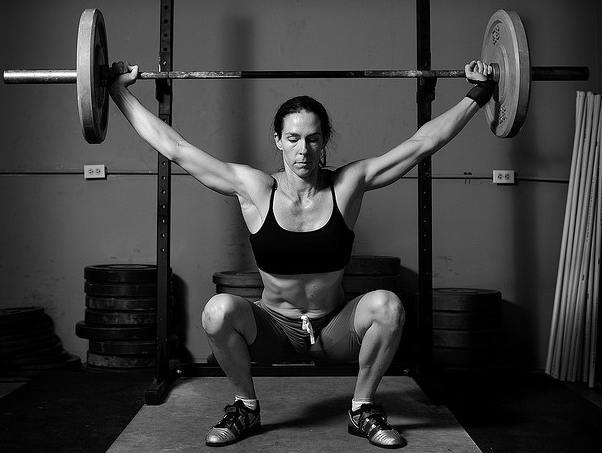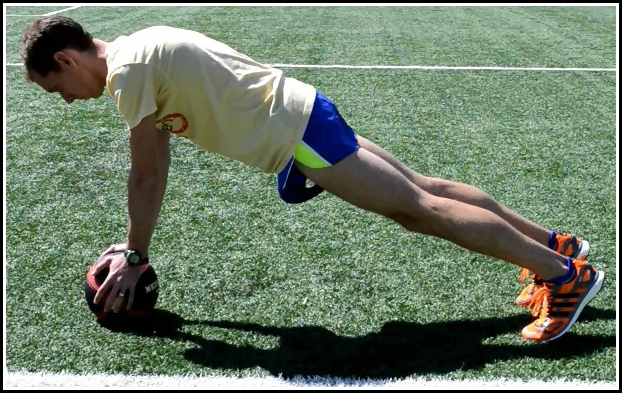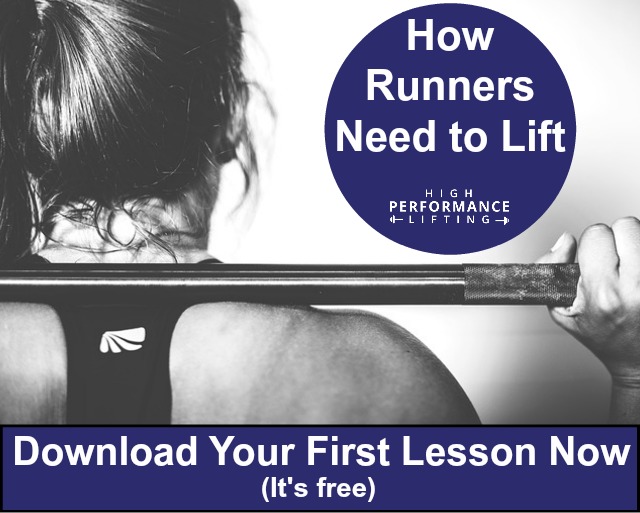There’s nothing sadder than the face of a runner sitting on the sidelines watching the world of runners go by. Yet high percentages of runners—from 37 percent to 56 percent—deal with injury on an annual basis.

Many factors can cause running injuries:
- excessive mileage
- ignoring niggles and allowing them to become full-blown problems
- muscle imbalances
But one simple act can play an important role in improved running economy and thus fewer injuries: strength training.
When you’re injured, it’s likely that your health practitioner, often a physical therapist who understands movement, is going to prescribe that you follow a strength routine. If you’re serious about staying injury free, this rehab routine can become your “prehab” routine as a foundation for running strength.
But bodyweight strength training for runners should go beyond a 10-minute prehab routine, as important as it is. And while most runners hate investing free time in the gym, it’s time well spent.
In fact, most coaches and physical therapists will go so far as to say that even if it means giving up a few precious miles on the road each week in order to find the time, strength training will pay off in spades.
Healthier, stronger, faster running can begin in the gym, whether a home-based, basement gym or one where you pay membership.
Bodyweight Strength Training for Runners: Clear Benefits
If you’d rather stay out of the gym, there’s plenty you can do at home, and beginning with a few simple bodyweight strength exercises, you can be well on your way.
But know that a progression in added weight, difficulty or resistance is necessary in the future.
Doctor of physical therapy and strength and conditioning coach Ryan Smith of Maryland-based health hub Recharge, says there are benefits to both types of strength training—bodyweight and with added resistance—but knowing how and when to progress is key:
When you work out with body weight only, you get to learn what your body can do in space. Plus it’s a good barometer of whether or not your body should even take on running.
What does Smith mean by that? It’s a simple numbers game:
- If your body cannot manage 20 reps of a single-leg calf raise, is it really ready for the impact of running?
- If you can’t balance on one leg and do single-leg dead lifts, what happens when you run?
Smith points out:
If the muscles that support your running aren’t able to function properly when running, what is taking over for them? Working with bodyweight exercises can be very illuminating in this regard.
Think about it: A weak or inefficient glute muscle might mean your IT band has to take over and compensate. It’s not designed for that kind of load and so what happens? It breaks down and you get IT Band Syndrome.
Or say your hip strength isn’t where it should be. Something must make up for that deficit. Maybe your peroneal tendon or your proximal hamstring? An injury probably isn’t far off on the horizon.
The benefits of bodyweight strength training for runners extends beyond only strength, however. Smith points to gymnasts who have exemplary control of their bodies to help you understand:
If you watch how they control their bodies in space, you can see this in action. They have phenomenal balance and awareness.
When you consider the fact that running is a series of one-legged stances, it makes sense to hone this skill and awareness.
Start with Bodyweight Strength Training

As a good starting point, then, let’s take a look at bodyweight strength exercises that do a runner good.
Smith says that a few key movements are particularly important:
Single-leg Squats
This is a fairly advanced movement, and one that many runners may need to work up to achieving. Smith notes:
You can work up to pistol squats or Bulgarian split squats. Both are difficult and provide real benefits to runners.
Your depth and range of motion may be limited to begin with, but with consistent practice, it can improve.
Single-leg squats are a valuable exercise included in the ITB Rehab Routine.
Single-leg Deadlifts
These moves work on glute strength, hamstring strength, balance, and spatial awareness. They aren’t easy, either, and might be helped by placing a mirror in front of you.
Start with one set of 8-10 reps and work up to two or three sets.
A variation of this valuable bodyweight strength training exercise is found in the Standard Warm-up Routine.
Lunges
There are almost endless ways to perform lunges and they provide important strength for the quads, hamstrings, glutes and overall lower limb function.
Consider front lunges, side lunges, reverse lunges and walking lunges as a good starting point. Shake things up from one workout to the next, too, to keep your body “learning” how to move properly.
Lunges are included in the Mattock Warm-up since they’re so critical for proper stride mechanics.
Plyometrics
By definition, plyometrics are fast, explosive movements. For runners, they can have a beneficial impact not only for building strength, but for improving running economy and speed.
Simple bodyweight plyometrics include a matrix of hopping. Ryan Smith adds:
Think about doing ‘skaters,’ skipping, standing long jumps (bounding), and lunges or squats with a jump. Try to land lightly but exploding off the ground.
Because they are a rather advanced move, you should build a foundation of strength first before attempting them.
Bodyweight Training Must Progress to Weightlifting
While bodyweight exercises serve a valuable purpose in a runner’s routine, if you don’t progress beyond them at some point, you risk stalling your gains.
Smith adds:
When you think about the fact that running produces loads of 1.2 to 1.5 times your bodyweight, you understand why it’s important to push your strength game. The body takes more demand during running than most runners realize.
So where do you go after mastering bodyweight movements? Smith suggests several options:
Single-leg squat variations: Once you have this movement pattern under control, consider making it tougher by adding dumbbells or kettlebells.
Getting easy? Keep on adding weight, reps and sets.
Single-leg dead lifts: Like its single-leg counterpart, the key to upping the ante here is grabbing kettlebells or dumbbells.
Challenge yourself even more by holding the weight in the opposing hand from the one on which you are standing. You’ll pull in more balance work with this approach, thus increasing the value of the move.
Lunges: Again, grab a kettlebell or dumbbell and get moving. As one weight gets easy, move up to the next. Or if you begin with dumbbells, move over to kettlebells, which are harder to manage.
Also try a kettlebell in each hand, holding them away from your body for a “farmer’s carry.” You’ll gain fantastic full-body strength.
Plyometrics: Ready to make these tougher? “You can take plyometrics to the next level by adding in height,” says Smith. “So try box jumps, or drop jumps from a higher position. There are lots of ways to increase the challenge here.”
Remember, however, to keep the variety in the picture, no matter what you can accomplish with the increased weights and challenges.
Smith says:
Our bodies adapt quickly. When you change things up, you’re increasing your capacity to run more.
You can learn more about Strength Running’s free strength series here (we’ll show you how runners need to lift).
Take the Next Step with Strength Training
Smith says that you will find weighted and bodyweight strength training mentally engaging (physically, too!):
Most of us get bored with the same routines, so variety keeps it fun. There are thousands of different ways you can shake it up but a basic foundation will make it easy for you.
Two to three times a week is all you need, but you have to stick with it to see the pay off.
If you haven’t yet tried consistent bodyweight strength training exercises, start there first. You’ll still get a tremendous amount of benefits without adding any extra weight to your lifts.
But if you’re comfortable doing bodyweight strength exercises, it’s time to take the next step and get into the weight room.
Weightlifting has several distinct advantages over bodyweight strength training:
- It results in higher levels of running economy (more efficiency)
- You’ll get more power, giving you a stronger finishing kick
- The injury prevention stimulus is stronger than bodyweight exercises
- You’ll also get stronger overall, resulting in better body composition
Register here for Strength Running’s best lifting guidance (and an example of a “power” lift).
You’ll learn more details about why you should lift, plus all the common mistakes that are typical in the weight room.
And the best part? Since most runners don’t lift appropriately, you’ll be WAY ahead of the pack after following a periodized, progressive, runner-specific strength program.
So sign up here, start lifting, and that next Personal Best will be right around the corner!
